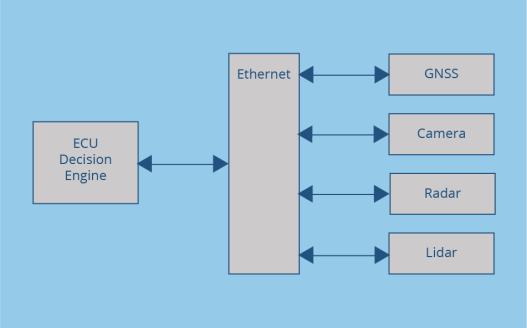Choosing the Right Timing Component for In-Vehicle Networking
The race to build fully autonomous vehicles is underway. As the finish line draws nearer, multiple technologies will be needed. Carmakers and ADAS providers already are adding more sensors and computing power into each model, but many overlook the role that timing will play.
Autonomous vehicles rely on cameras, lidar, radar, and other types of sensors to navigate the roads. These sensors generate a tremendous amount of data, which is fed into an engine control unit that makes critical decisions based on real-time information. To connect the sensors with the decision engine, many designers are relying on 10G, 40G, and 100G Ethernet, which requires a low-jitter oscillator that can handle the challenging conditions of a car.

Jitter is the difference between expected and actual timing edges in a system. The worse it becomes, the more adversely it affects the system. In the case of autonomous driving, jitter can impact how quickly data is sent from sensors to the decision engine, and on the road, where the vehicle surroundings are always changing, any lag in data transmission can be problematic.
In addition to low jitter, timing components must provide reliable and robust performance that’s maintained during operating conditions experienced while on the road. Here’s a checklist that will ensure your timing solution has all the features you need for dependable in-vehicle networking:
- AEC qualification
- Immune to shock and vibration
- High reliability
- High performance in the presence of board noise
- A range of frequencies, including 156.250000 MHz required for Ethernet applications
- The ability to maintain stability during fast temperature transients
- Standard differential output signaling types
- Exceptional RMS phase jitter
- Reliable suppliers
The SiT9386 and SiT9387 oscillators fit the bill. These devices are part of the Elite Platform™ of MEMS-based differential oscillators from SiTime. This platform uses a proprietary DualMEMS™ architecture that provides stable timing and superior robustness against external stressors that are common in automotive environments, such as shock, vibration, board noise, wide temperature range, and fast temperature transients. Compared to quartz timing devices, the SiTime solutions offer:
- 30 times better shock performance
- 20 times better reliability (over 1 billion hours MTBF)
- 10 times better performance in the presence of board noise (0.02 ps/mV PSNR)
The AEC-100-qualified SiT938X oscillators provide the following features:
- AEC-Q100 with extended temperature range (-40°C to +105°C)
- Any frequency between 1 to 725 MHz (including 156.250000 MHz required for most Ethernet applications)
- LVPECL, HCSL, and LVDS output signaling types
- Stability as low as ±25 ppm over temperature maintained during fast temperature ramp
- RMS phase jitter (random) <300 fs (typical)
These differential oscillators will propel the automotive industry forward in their development of driverless cars. They deliver stable and reliable timing for AI processors in automotive supercomputers, as well as for the interfaces that move data, such as PCI Express and 10G, 40G, and 100G Ethernet. To learn more about the SIT9386 and SiT9387, check out these resources: